|
1.
CENTRAL/ WEST AFRICA
Prices hold steady in West Africa
There is no change in the market since the end of July.
Sustained business with China, Vietnam and India
continues to hold export prices and volumes steady, a
trend similar to the past two months. Trade with European
buyers is still very slow and neither exporters nor
importers appear to be expecting a sustained improvement
in business with Europe in the short to medium term. The
modest price gains for some species in July have held and
there are reports that demand for okoume logs has been
particularly high.
The ongoing demand for the very selective number of
favorite species is not likely at this stage to tempt
producers into any prompt reactivation of logging. The
emphasis on so few species does tend to mask the lack of
interest in other species available in most forest
concession areas, forcing loggers to log very selectively,
resulting in a rise in the cost of extraction. Although most
world stock markets have made some gains in the past two
weeks, economists continue to warn that the underlying
market prospects remain very fragile and recovery to
normal trade conditions is many months if not years away.
This is certainly the view of many in the West African
timber industry as the boom years in building construction
in consumer countries such as Spain, Portugal, the US and
UK are over and unemployment is climbing. Some timber
trade representatives have recently commented that the
tropical hardwood trade may not decline further from the
present low level, but it is not likely to return to the
volumes traded in the past three or four years.
For the present, West African log and lumber exporters
have survived through a very difficult 12 months, thanks
to continued demand from the Asian market. It is
anticipated that if these markets hold, the companies
benefiting from this trade will continue to do so through
the third and fourth quarters. The expectation remains that
2010 will bring some revival in European business.

2. GHANA
Ayum sets pace for best timber practices
Ayum Forest Products Ltd, a forest resource concession
holder in the Asunafo North Municipality of the Brong
Ahafo Region, has committed about USD500 million
towards a reforestation project in the degraded Amama
Forest Reserve at Atronie, near Sunyani. Since the
programme began in 2003, the company has planted over
five million indigenous tree species. According to The
Daily Graphic, the new initiatives are designed to show
the company¡¯s best timber practices. The tree species
planted in the degraded areas, covering about 42.28 square
kilometers, include cedrela, ofram, ceiba, mahogany,
edina, wawa, utile, emirem chenchen, koto, kokrodua,
mansonia, asanfina, makore, akasaa and otie.
Currently, the company sources about 80% of all wood
material input from its own concession areas and its
current forest management practices are in line with the
laws and regulations of the Forestry Commission (FC) as
well as its logging manual. In addition, the company is
highly committed to forest restoration in degraded areas
and reclamation of log siding in productive forest areas
using indigenous species. As one of the largest timber
companies and a leader in timber products from Ghana,
Ayum has the opportunity to positively influence the
Ghanaian landscape through its commitment to
responsible forestry practices to become a leader in the
sub-regional forest products industry.
Recently, the company joined the Global Forest and Trade
Network ¨C West Africa, thereby committing its forest
concessions to be responsibly managed, including through
the use of credible certification systems. In addition to the
forest concessions under the company¡¯s management,
Ayum also agreed to implement responsible procurement
policies for the timber entering sawnwood, veneer and
plywood mills. The company¡¯s forest reserves are crucial
to the conservation and protection of biodiversity in the
Guinean Moist Forest Eco-region, which is considered the
most biodiverse region in West Africa. At a press briefing,
Ayum¡¯s Director of Operations Mr. Akufo Owoo hinted
the company adopted a waste management system to
ensure proper management and disposal of waste at all
levels of the company¡¯s operations. Ayum is also a
beneficiary of an ITTO pilot scheme on timber tracking.

3.
MALAYSIA
Trade event expected to draw about 50,000 visitors
Organizers of the Malaysia International Commodity
Conference & Showcase (MICCOS), to be held from 13-
16 August 2009, expect the event to draw up to 50,000
visitors. The Malaysian Timber Council will be organizing
a major business-matching session during the event, which
will include at least 49 delegates from 35 companies from
16 countries including China, Germany, Greece, Hungary,
India, Pakistan, Poland, United Arab Emirates and
Uzbekistan. According to The Star Online, about 100
business representatives from 61 Malaysian timber-based
companies will also be participating in the businessmatching
session at MICCOS. The president of the
National Smallholders Association (NASH), Datuk
Aliasak Ambia said the event would provide small
businesses a good opportunity to be updated on the latest
market information on cash crops such as palm oil and
rubber.
Malaysian furniture manufacturers will also be
participating in the Furniture China trade exhibition to be
held at the Shanghai International Exhibition Centre
(SIEC) and the Redstar Macalline Global Furnishing
Trade Center (RMGFTC) from 9-12 September 2009.
Furniture Today reported the trade show will feature 1,800
exhibitors occupying 2.3 million square feet at the SIEC
and another 500 exhibitors occupying about 1.8 million
square feet at the RMGFTC.
New Zealand seen as model for Malaysia¡¯s plantation development
The Malaysian Deputy Ministry of Plantation Industries
and Commodities Hamzah Zainuddin said that Malaysia
should emulate the management practices of forest
plantations in New Zealand in order to stimulate research
and development in the timber sector. According to
Bernama, the Deputy Minister was leading a delegation
from Malaysia to New Zealand to discuss cooperation
between the two countries in the timber sector.
Drought and haze hit Sarawak
Bernama reported that timber logging activities in
Sarawak were being reduced as a combination of drought
and haze has covered the state of Sarawak. The drought
brought about by the El Niño effect has been depriving
timber logging camps of drinking water and sanitation.
The drought has also created extremely dry conditions in
the forests, making it very susceptible and vulnerable to
fires. Deputy Chief Minister Mr. George Chan, who is also
the chairman of the state Disaster Management and Relief
Committee, has activated disaster operations across the
state. The situation may create a temporary shortage of
logs that will arrest any decline in prices for timber
products in Sarawak. However, prices are unlikely to
strengthen as there are adequate supplies of raw logs and
other timber products in Sarawak.

4.
INDONESIA
Sengon used as alternative to raw materials from production forests
Timber products manufacturers in Java are increasingly
turning to sengon wood as an alternative raw material,
reported The Jakarta Post. As a result, its price has
quadrupled to Rp 800,000 (USD79) per m³ over the last
four years. Sengon wood is preferred by many
manufacturers as the tree is highly adaptable to most soil
conditions and has a 5 to 10 year gestation period. The
physical properties of the wood also meet the requirements
of manufacturers for a wide range of timber products.
With some companies utilizing up to 80% of sengon wood
as raw material, competition for the wood has become
keen. Prices of the wood of a higher quality are anticipated
to hit Rp. 1 million per m³. As such, some companies
have resorted to buying other lesser-used species such as
coconut and oil palms as a source of raw material.
However, sengon wood remains a favorite among timber
products manufacturers in Java which are reported to have
processed and used up to 4 million m³ of the wood over
the last three years.
New certification system to take effect in September
The Jakarta Post reported that by 1 September 2009, a
new certification system would be in place for the
country¡¯s log and wood products produced by local
companies. The Institute of Independent Evaluators and
Verifiers (LPVI) will be responsible for issuing certificates
for these products as well as standardization documents to
licensed holders of forest management units, production
forests and community forests. The system will apply to
Indonesian products sold domestically and internationally.
Until now, the Board for the Revitalizing the Forest
Industry (BRIK) has been in charge of issuing certification
documents for exported products and will continue to do
so until LPVI is ready to take over BRIK¡¯s
responsibilities. Unlike BRIK, LPVI will comprise more
non-governmental, independent and professional experts.
Ministries wrangle over rattan quotas
Uncertainty continues to prevail over quotas imposed on
rattan exports involving the Indonesian Trade Ministry and
the Industry Ministry, reported The Jakarta Post. The
quotas imposed under a new regulation, which constitutes
the fourth revision of a 2005 regulation, have remained
unchanged despite mounting calls to reduce or completely
ban rattan exports in order to address the acute shortage of
the raw material. However, Industry Minister Mr. Fahmi
Idris indicated that the quotas could be amended as the
new regulation was still undergoing further revision.
The Industry Ministry reveals that the country produces
600,000 tons of raw rattan annually, which represents 75%
to 80% of the world¡¯s total production. Sumatra,
Kalimantan, Sulawesi and Papua are the main rattanproducing
regions in Indonesia. The Indonesian Furniture
Entrepreneurs Association (Asmindo) said the local annual
demand for the commodity amounts to 300,000 tons.
The Industry Ministry and Asmindo, which represents
rattan producers and craftsmen, have called on the Trade
Ministry to curtail raw rattan exports further, while the
Indonesian Rattan Furniture and Craft Association
(AMKRI) is demanding that the Trade Ministry should
cease issuing export permits for the commodity. AMKRI
Chairman Hatta Sinatra commented that the country might
not be able to meet local demand, estimated at up to
USD300 million, if the government did not curtail exports
of rattan.
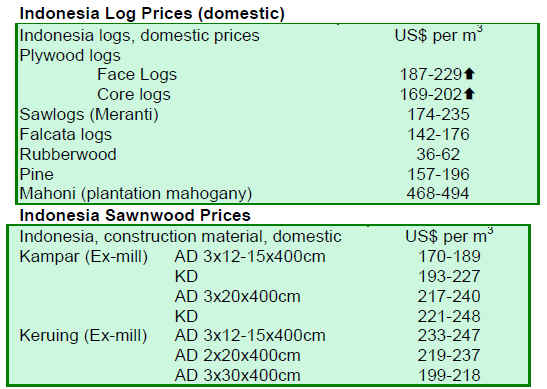
5.
MYANMAR
Active purchasing points to market recovery
Export products from Myanmar such as freshly cut teak,
pyinkadoe and gurjan have been selling in reasonable
quantities. Buyers say grading and pricing are the key
elements to bringing the market back to normal. Insofar as
pricing is concerned, Myanmar Timber Enterprise (MTE)
is reluctant to adjust prices downward, while grading has
been reviewed to accommodate the needs of the day.
Given the current trading patterns in Myanmar, it seems to
be an optimistic time for some and buyers hope positive
trends will continue in the months ahead.
Timber transport by road to Yangon is most feasible
The Bi-Weekly Eleven journal and Myanmar Post noted
the discussion of a paper presented recently at a meeting
of the Myanmar Timber Entrepreneurs¡¯ Association. The
paper discussed the pros and cons of relying on various
methods of transport in the country including by river, rail
and road. The paper stressed the need to observe ASEAN
standards for axle load, weight and dimension limits to
reduce wear and tear on existing roads and highways. The
paper also indicated that transport of logs to Yangon was
most feasible by trucks.
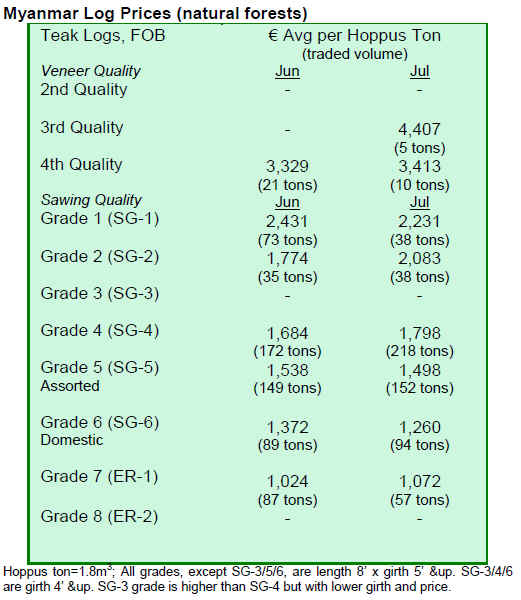

6. INDIA
Indian housing sector gets a boost from government
stimulus measures
The beginning of August showed positive results for
India¡¯s realty sector. The Ministry of Finance announced
incentives to the building industry, extended tax breaks for
realtors by three years and offered individual buyers of
homes subsidies on the interest on loans up to Rp.1 million
per year provided the purchase price of the home is not
more than Rp.2 million. The government earmarked about
Rp.10 billion for these provisions, which are expected to
offer benefits to low and middle-income families.
The Ministry also proposed an amendment to the Income
Tax Act, whereby profits from housing projects approved
by a local authority between 1 April 2007 and 31 March
2008 would be tax free if completed by 31 March 2012.
The government has urged the builders to pass on the
benefit to the consumers. There is an immense shortage of
dwelling units in the country, as it is expected that about
47.4 million new dwelling units in rural areas and 26.5
million in urban areas will be needed by 2012.
The measures announced by the government have been
well-received by the construction industry and are
expected to give a boost to wood working industries as
well. Plywood alone accounts for 78% of the wood panel
market in India, with the rest being composed of
engineered panels such as MDF and particleboard. For the
housing interiors industry, the Indian market is still
dominated by plywood and blockboard. However, the
trend is gradually changing with a growing market share
for plywood and blockboard and an increasing share of
particleboard and MDF.
With the housing sector getting a boost, interior wood
products comprised of decorative panels, wooden
floorings and ready made furniture also gets a lift. India is
a net importer of furniture. Small quantities of furniture
are being exported representing not more than 0.25% of
the global furniture industry. At present, the furniture
sector is predominantly in the hands of unorganized small
units. Fortunately, large corporate houses have started
taking interest in production of modern furniture and
prominent names like Godrej and Wipro have entered the
furniture manufacturing business.
The government has also extended tax breaks to industrial
parks. Companies working from industrial parks can now
plan for the long-term with tax breaks extended for two
years, until 31 March 2011. Profits from development,
operation and maintenance of industrial parks will
continue to be tax-free. The Federation of Indian
Chambers of Commerce and Industry have welcomed
these measures that should give new momentum to the
economic recovery currently under way.
Corporate results for 2008-2009 have shown positive
growth for most companies, including plywood and
woodworking producers. The overwhelming consumer
needs from urban and rural areas have sustained demand
for tropical hardwoods like balau, merbau, and keruing
from Malaysia and Myanmar and also teak from
Myanmar, Tanzania, Nigeria, Ghana and Central
American and South American countries. However, the
Sabah state government in Malaysia has restricted log and
sawn exports to India. This will make prices of logs
suitable for the plywood industry more competitive. India
substantially depends on imported hardwoods like gurjan
and keruing for plywood faces. Other than face veneers for
core material, Indian factories are able to get local
hardwoods from agroforestry and plantations in the
country.
India¡¯s forest cover stands at 23.6% of the total
geographical area. Sustained efforts by the government
and the local community are improving the forest cover. It
is estimated that by the end of 2010 total forest cover
could reach 25% and 30% by the end of 2012. The Indian
government also has set a long-term target of increasing
the country¡¯s forest cover to 33%. Private and forest
department tree planting is expanding.
In post-independence India, a new festival ¡®Van
Mahotsav¡¯, has been introduced. The season for Van
Mahotsav, which literally means ¡®Festival of Forests¡¯, is a
week in July. During this period, every state in the country
plants large number of trees. The forest department also
helps local communities and village-level panchayats to
plant millions of saplings, which are mostly distributed
free of cost. For planting in urban areas, the saplings are
distributed at nominal charge of about Rp. 1 per sapling.
Many social organizations bear these costs and urge the
people to take away the saplings free and plant as many
trees as they can in and around their dwellings.
Teak prices on an upward trend
Prices for local teak have been showing an upward trend.
Despite the monsoon season, most timber offered for sale
is sold. Imports are also steady, augmenting supplies to a
great extent. Besides helping housing and industrial
infrastructure, the imports help forest conservation efforts
in the country. The current prices for imported teak of
various origins are as follows:
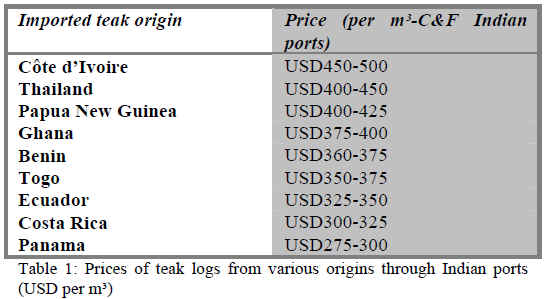
Different measurement systems are used by exporters from
different countries and if the importer is not well versed he
loses profits. The reactivated Teaknet is planning to take
up the matter of uniform specifications, measurement
systems and allowances for sapwood and bark and some
guidelines on uniform price vis-¨¤-vis classifications.
In India, the local practice is to measure the logs under the
sap, regardless of the species. Even in African countries,
timber such as padauk is measured under sap. For the
protection of buyers and consumers, the ideal system
would be to measure the logs under the sap so the question
of allowance for sapwood and barkwood would not arise.
Teaknet is expected to take up this matter in due course,
possibly at its next international seminar planned for the
month of November 2009.
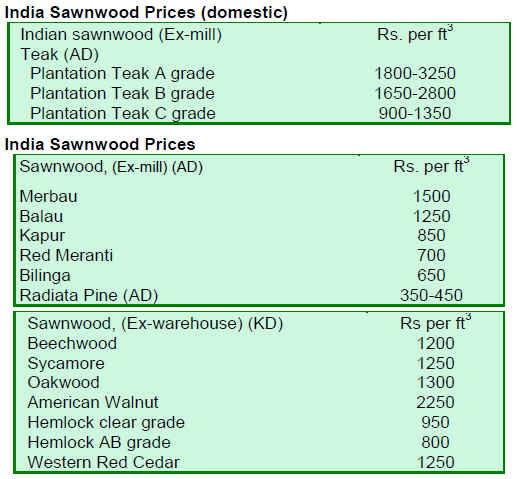
7. BRAZIL
Brazil offers national forests for auction
By the end of 2010, over 2.7 million hectares of national
forests in Brazil will be offered for auction, according to
the estimate of the Brazilian Forest Service (SFB in
Portuguese), the agency responsible for the auction
process. Thus, the timber supply from legal and
sustainable sources is estimated to reach a total of 840,000
m³.
The Annual Plan for Forest Concession (PAOF) 2010,
which defines the concession areas for sustainable
harvesting was signed in Brasilia by the Minister of
Environment, reported MMA/ASCOM. The measure will
contribute to revenue generation of nearly BRL430 million
to both the government and the industry - in addition to
12,000 direct and indirect jobs. Until now, some 90,000
hectares in the country had been auctioned within a single
Conservation Unit, the Jamari Flona (National Forest) in
the Northern state of Rondônia.
According to SFB, the concessions will expand the
sustainable forest area for harvesting and provide an
opportunity to the timber sector to purchase legal products.
To the Ministry of the Environment (MMA), the creation
of sustainable economic activities is an important
alternative to combating deforestation, since the
supervision of forest management and penalties for
inappropriate harvesting are not sufficient to control the
destruction of the forests.
This year, nearly 1 million hectares will be offered for
bidding in three auctions. One has already opened, the
Sarac¨¢-Taquera Flona, which covers 140,000 hectares.
Later this year, auctions of the Amana and Crepori
National Forests, in the state of Par¨¢, will be announced.
Among the possible buyers of the concessions are
companies that consume wood raw materials, forest
service providers, machinery companies, equipment and
forest suppliers and communities living around the
concession areas.
Minas Gerais¡¯ stands to gain from federal programme
Even with the slowdown of furniture sales in the first half
of 2009, the Minas Gerais¡¯ furniture sector foresees a
promising year, reported O Tempo. Compared to 2008, a
7% growth in revenue amounting to BRL190 million is
expected in 2009. Additionally, with the completion of the
first house under the federal programme ¡®My House, My
Life¡¯ in 2010, the prospect for increased sales in such
homes is 30%, according to the Ub¨¢ Inter-Municipality
Union of Furniture Industry (INTERSIND).
The Union represents 400 furniture companies in the
regional cluster. It expects domestic sales to expand next
year and have a positive impact on revenues from
investments in the real estate market. In the first half of
2009, furniture exports fell 50% compared to the same
period of 2008. With the slump in exports, especially due
to the global economic crisis, the industry is increasingly
targeting the domestic market. The ¡®My House, My Life¡¯
programme is expected to boost sales, as those who buy
new homes also need new furniture.
According to the Minas Gerais Furniture Merchants and
Representatives Association, furniture sales in the first two
months of 2009 were low as result of consumers¡¯ limited
interest in purchasing home furniture. To avoid the worst,
companies worked to maintain minimum sales. As the
crisis appears to be coming to an end, companies need to
continue their work, considering that the domestic market
is expanding and offering an opportunity to grow.
Exports of Brazilian solidwood products tumble amid
global financial crisis
Brazilian exports of solidwood products have been
declining since 2007, and the situation has become even
more serious for the sector since the beginning of the
financial crisis. According to Ag¨ºncia Brasil / O Liberal,
the crisis has affected exports from traditional solidwood
producing regions in Brazil. According to the Paran¨¢
Wood Industry Union, in the first six months of 2009,
solidwood exports from the country fell 43% by volume
compared to 2008. In Paran¨¢, the fall in sales in the last 20
months was 54%, which included lumber, pine and
tropical plywood, door and solidwood product sales from
other segments. The state employs about 600,000 workers
in the timber industry comprising 1,200 companies
affiliated to the Union. As companies have made
adjustments following the financial crisis, nearly 6% of the
workers have been laid off in the first half of the year.
In the Northern state of Par¨¢, exports of solidwood
products in the first half of 2009 plummeted 52.9% by
value compared to the same period of 2008, according to
the Par¨¢ Timber Exporters Association (AIMEX).
Although exports by volume rose 1.7% from May to June
2009, the devaluation of the Brazilian real against the US
dollar hurt producers, with revenues dropping 2.3% over
the period, resulting in a loss of nearly USD 660,000.
The main factors contributing to the poor performance of
the industry are high tax burdens; low demand from
external markets; fierce competition with other tropical
countries such as Malaysia and Indonesia; high interest
rates for small and medium producers; and the fluctuation
of exchange rates. The recovery of timber exports,
according to AIMEX, is expected to occur from October
2009. The expectation is that the crisis will start to
slowdown and the civil construction industry abroad will
strengthen, consequently improving prospects for exports
of Brazilian solidwood products.
High costs deter forest product certification
Although it has become a condition for some companies to
access external markets, certification of wood and nonwood
products is still resisted by some small and medium
sized companies, reported Folha de São Paulo. As
observed by the Forest Stewardship Council in Brazil,
companies¡¯ reasons for not certifying include the high cost
of certification and the process of compliance with
environmental and labor standards.
At times, the costs for adjusting forest management areas
and chain of custody are higher than the cost of
certification itself. Nevertheless, the Brazilian companies
that do invest in certification confirm having benefited
from greater opportunities to exports.
In addition, the INMETRO (The National Institute of
Metrology, Normalization and Industrial Quality) also
certifies forest companies that operate in a sustainable
way. The CERFLOR (Brazilian Program of Forest
Certification) was established in 2002 by INMETRO
under which more than 1 million hectares of natural and
planted forests nationwide have been certified.

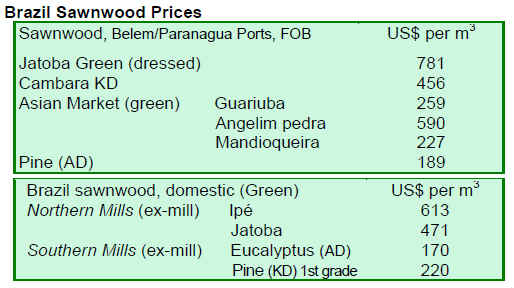
8.
PERU
FTA can boost Peruvian exports to the EU
EU representatives anticipate growth in Peru¡¯s agricultural
exports to the EU, if the EU and Peru were to sign a Free
Trade Agreement (FTA). Rupert Schlegelmilch, chief
negotiator for the EU, commented that Peruvian products,
particularly certified wood and other popular agricultural
products, have a high potential to enter the European
market under preferential tax rates, since they are in high
demand in the region. Schlegelmilch hopes to finalize the
FTA by the next meeting of the two groups in Brussels
during September 2009 and for the FTA to be signed by
the end of this year.

9. BOLIVIA

10. MEXICO
Mexico aims to restore degraded land
Over the past seven years, Mexico has worked to conserve
and restore soil quality covering about 600 thousand
hectares in the country. During the period 2001-2007, the
National Forest Agency, with the support of owners of
forest land, restored 596 thousand hectares of land and soil
in the country, involving an investment exceeding 540
million pesos. The states suffering from a greater degree
of deterioration of soil and forest resources are considered
priority areas. They include Oaxaca, Chiapas, Quintana
Roo, Jalisco, the state of Mexico, Chihuahua and Durango.
CONAFOR, through ProTree, has promoted various
activities to prevent soil degradation through: reforestation
and soil enrichment; construction and land restoration;
maintenance; and soil conservation. Mexico is working
through some 29 federal entities to promote sustainable
management of agricultural and forest lands. To
strengthen efforts toward the sustainable management of
soils, many institutions also took part in drafting the
National Strategy for Sustainable Land Management,
aimed at developing public policies that support
sustainable management of land. The Strategy will be
issued in the coming months and will be presented as a
tool to tackle the problem of land degradation.
11.
Guyana
Prices for popular log species mark further gains
Log prices for greenheart have further improved, with
mora prices remaining relatively stable for the period 16-
31 July 2009 as compared to the previous period of 1¨C15
July 2009. Prices for purpleheart undressed sawnwood
(812/649) have been positive, while greenheart dressed
sawnwood (1165/806) and purpleheart (1126/806) have
showed significant price increases over the same period.
Prices for plywood in the BB/CC and utility category for
the period 16¨C31 July 2009 were also favorable. Prices for
splitwood (2344/975) and roundwood have showed gains
during the same period. Value-added products, such as
doors, mouldings and outdoor furniture have also recorded
higher average prices for the end of July compared to the
first half of July, with outdoor furniture gaining export
value earnings significantly.
Local producer receives top award for innovative activities
In recognition of its innovative contributions to local
business, Bulkan Timber Works was awarded the country
Prize during the 2009 Pioneers of Prosperity Caribbean
Awards Competition, according to the Stabroek News. The
will now compete with entrepreneurs from The Bahamas,
Barbados, Belize, Haiti, Jamaica and Trinidad & Tobago
for the regional prize this September in Jamaica.
Receiving the prize on behalf of the company was
Managing Director, Howard Bulkan, who has been
involved in the business for approximately 38 years.
Bulkan Timber Works Inc. was formed in 1997,
manufacturing and exporting value-added wood products
specifically for overseas markets. Currently the business
has over fifty employees. As the country winner, Bulkan
Timber Works will receive a grant from the Inter-
American Development Bank¡¯s (IADB) Multilateral
Investment Fund of USD40,000 to be invested in training
and technical infrastructure for the company.
The Pioneers of Prosperity Programme is sponsored by the
IADB¡¯s multilateral investment fund, the John Templeton
Foundation, and the Social Equity Venture Fund (S.E.
VEN Fund). The programme seeks to inspire a new
generation of entrepreneurs in emerging economies by
identifying, rewarding and promoting outstanding
businesses to serve as role models for the community.
According to the Programme¡¯s website, the winners are
chosen on their ability to: create unique value for
customers through innovative products and/or services;
generate a sustainable profit for owners/shareholders
commensurate with the risks taken by investing in them;
invest in their employees through training; create safe
working conditions; increase salaries; and protect the
future by strengthening local and global environments and
communities.


|